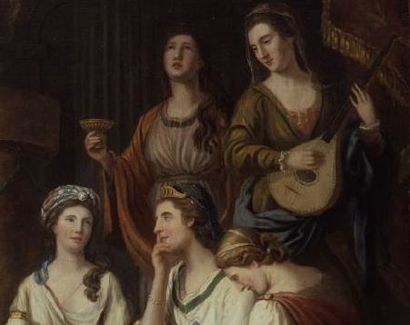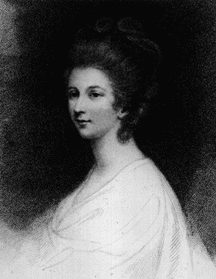Charlotte Lennox facts for kids
Charlotte Lennox, born Charlotte Ramsay (around 1729 – January 4, 1804), was an important Scottish writer. She wrote novels, plays, poems, and essays. She also translated books and edited a magazine. Charlotte Lennox is best known for her novel The Female Quixote. She was also connected to famous people like Samuel Johnson, Joshua Reynolds, and Samuel Richardson. Even with these connections, she had a long and successful career all on her own.
Contents
Her Life Story
Charlotte Lennox was born in Gibraltar. Her father, James Ramsay, was a Scottish captain in the British Army. Her mother, Catherine Tisdall, was Scottish and Irish. She was given the name Barbara Charlotte Ramsay. We don't know much about her early life directly. What we do know comes from hints in her first novel, which seems to be partly about her own experiences.
Charlotte lived in England for her first ten years. Then, in 1738, her family moved to Albany, New York. Her father was a lieutenant-governor there. He passed away in 1742. Her time in the American colonies likely inspired her first and last novels, Harriot Stuart (1750) and Euphemia (1790).
Around age 13, Charlotte was sent to London. She was supposed to live with her aunt, Mary Lucking. But when she arrived, the plans changed. Instead, Charlotte became a companion to Lady Isabella Finch. Lady Isabella was impressed by Charlotte's writing.
Becoming a Writer and Actress
Charlotte Lennox published her first book of poems, Poems on Several Occasions, in 1747. She dedicated it to Lady Isabella. The poems often talked about female friendship and being independent. She might have been offered a job at the royal court. However, she decided to marry Alexander Lennox. She also chose to become an actress and publish her own works to earn money. Her husband worked in a customs office for a while. This job was reportedly given to him because of his wife's writing.
In 1746, at age 17, Charlotte started acting. This was her first public role, moving away from relying on wealthy sponsors. She performed in plays at Drury Lane Theatre that explored social issues. After her first poems were published, she started focusing more on writing. She still acted occasionally, including a performance in 1748 and a special show at the Haymarket Theatre in 1750. In 1750, she also published her popular poem, "The Art of Coquetry," in Gentleman's Magazine.
Around this time, she met Samuel Johnson, a very famous writer. He thought highly of her. When her first novel, The Life of Harriot Stuart, Written by Herself, came out, Johnson threw a big party for her. He even had a special laurel wreath and an apple pie with bay leaves! Johnson believed Charlotte was better than his other female writer friends, like Elizabeth Carter and Frances Burney. He admired her for trying to make writing her full-time job, instead of writing secretly. He helped her meet important people in London's writing world.
However, some women in Johnson's group, like Hester Thrale and Elizabeth Carter, didn't like Charlotte very much. They criticized her housekeeping or her personality. They sometimes saw her as someone who caused trouble.
Her Most Famous Novel
Samuel Richardson and Samuel Johnson both reviewed Charlotte Lennox's second and most successful novel, The Female Quixote, or, The Adventures of Arabella. Henry Fielding, another famous writer, praised it too. The book became quite popular. It was reprinted many times and translated into German, French, and Spanish.
The Female Quixote is a clever story that flips the famous Spanish novel Don Quixote around. In Don Quixote, the main character thinks he is a knight from old romance stories. In The Female Quixote, the main character, Arabella, believes she is a princess or heroine from romance novels. She thinks she can kill people with a look and that her admirers must go through difficult challenges for her.
The Female Quixote was published without Charlotte Lennox's name on it. But it was an "open secret" that she wrote it. Her other books were advertised as being by "the author of The Female Quixote."
Translations and Literary Criticism
Charlotte Lennox learned several languages. She was taught Italian by Joseph Baretti. She also got help translating The Greek Theatre of Father Brumoy, an important French study of Greek plays. In 1755, she translated Memoirs of Maximilian de Bethune, Duke of Sully, which sold well.
Charlotte Lennox was very interested in the stories that William Shakespeare used for his plays. In 1753, she published the first two volumes of Shakespear Illustrated. A third volume came out in 1754. Many scholars see this work as one of the first feminist literary criticisms. In it, Lennox looked closely at Shakespeare's sources, especially old romance stories. Her main point was that Shakespeare's plays often made female characters less powerful and independent than they were in the original stories.
Samuel Johnson wrote the dedication for this work. But some people, like the famous actor David Garrick, criticized her for how she treated Shakespeare's work. Even though Johnson's support protected her reputation, the literary world got back at her when her play, The Sister, was performed. This play was based on her third novel, Henrietta. On its opening night, several groups of people planned to boo the play off the stage. Even so, the play was published and went through several editions.
Later Works and Life
Her third novel, Henrietta, came out in 1758 and sold well. However, it didn't earn her much money. From 1760 to 1761, she wrote for a magazine called The Lady's Museum. This writing later became her 1762 novel, Sophia. David Garrick also produced her play Old City Manners in 1775. This play was an updated version of an older play by Ben Jonson.
Finally, in 1790, she published Euphemia, her last novel. It wasn't very successful because people's interest in romance novels had changed. Euphemia is a novel told through letters and is set in New York State before the American Revolution.
Charlotte Lennox had two children who lived past infancy: Harriot Holles Lennox (1765–1802/4) and George Lewis Lennox (born 1771). She and her husband were separated for many years and officially parted ways in 1793. Charlotte lived in poverty for the rest of her life, getting help from the Literary Fund. She died on January 4, 1804, in London. She was buried in an unmarked grave.
In the 1800s, The Female Quixote remained somewhat popular. In the 1900s, feminist scholars like Janet Todd and Nancy Armstrong praised Charlotte Lennox for her skill and creativity.
Her Works

Poetry
- Poems on Several Occasions (1747)
- The Art of Coquetry (1750)
- Birthday Ode to the Princess of Wales
Novels
- The Life of Harriot Stuart (1751)
- The Female Quixote (1752)
- Henrietta (1758)
- Sophia (1762)
- Eliza (1766)
- Euphemia (1790)
- Hermione (1791)
Plays
- Philander (1758)
- The Sister (1769)
- Old City Manners (1775)
Literary Criticism
- Shakespear [sic] Illustrated (1753–1754)
Periodical
- The Lady's Museum (1760–1761)
Translations
- 1756 Memoirs of Maximilian de Bethune, Duke of Sully
- 1756 The Memoirs of the Countess of Berci
- 1757 Memoirs for the History of Madame de Maintenon and of the Last Age
- 1759 The Greek Theatre of Father Brumoy
- 1774 Meditations and Penitential Prayers by the Duchess de la Valière
See also
 In Spanish: Charlotte Lennox (escritora) para niños
In Spanish: Charlotte Lennox (escritora) para niños



